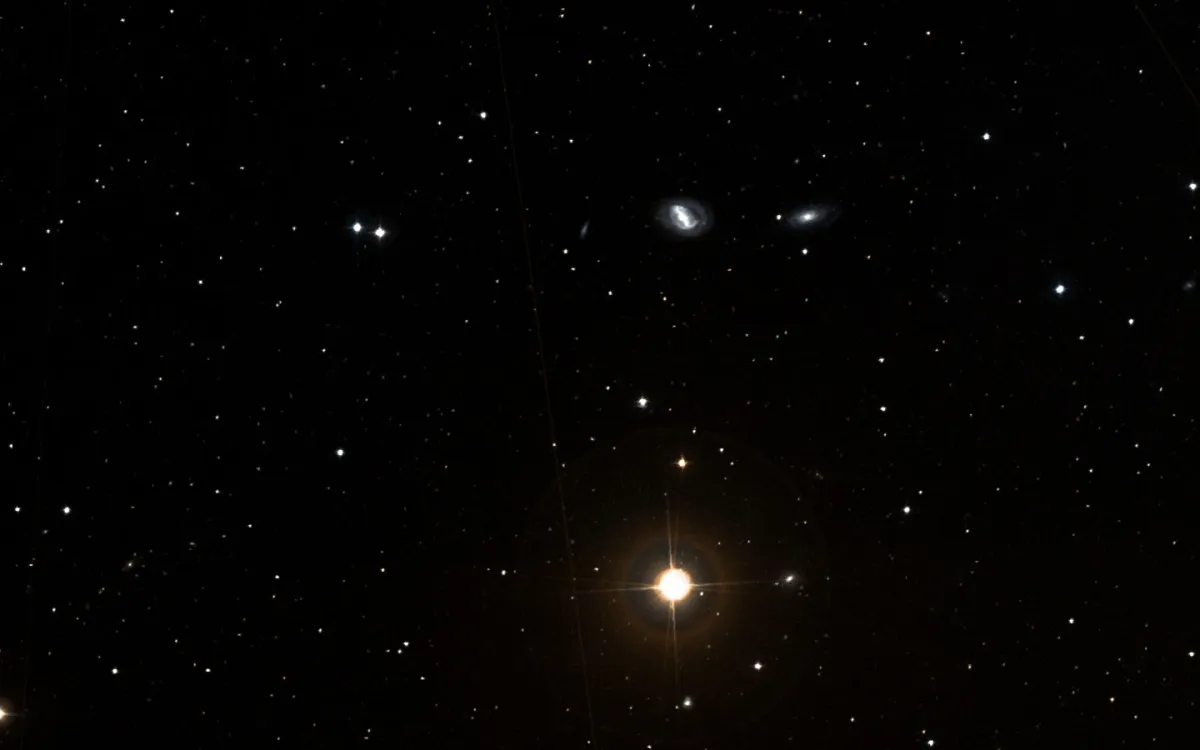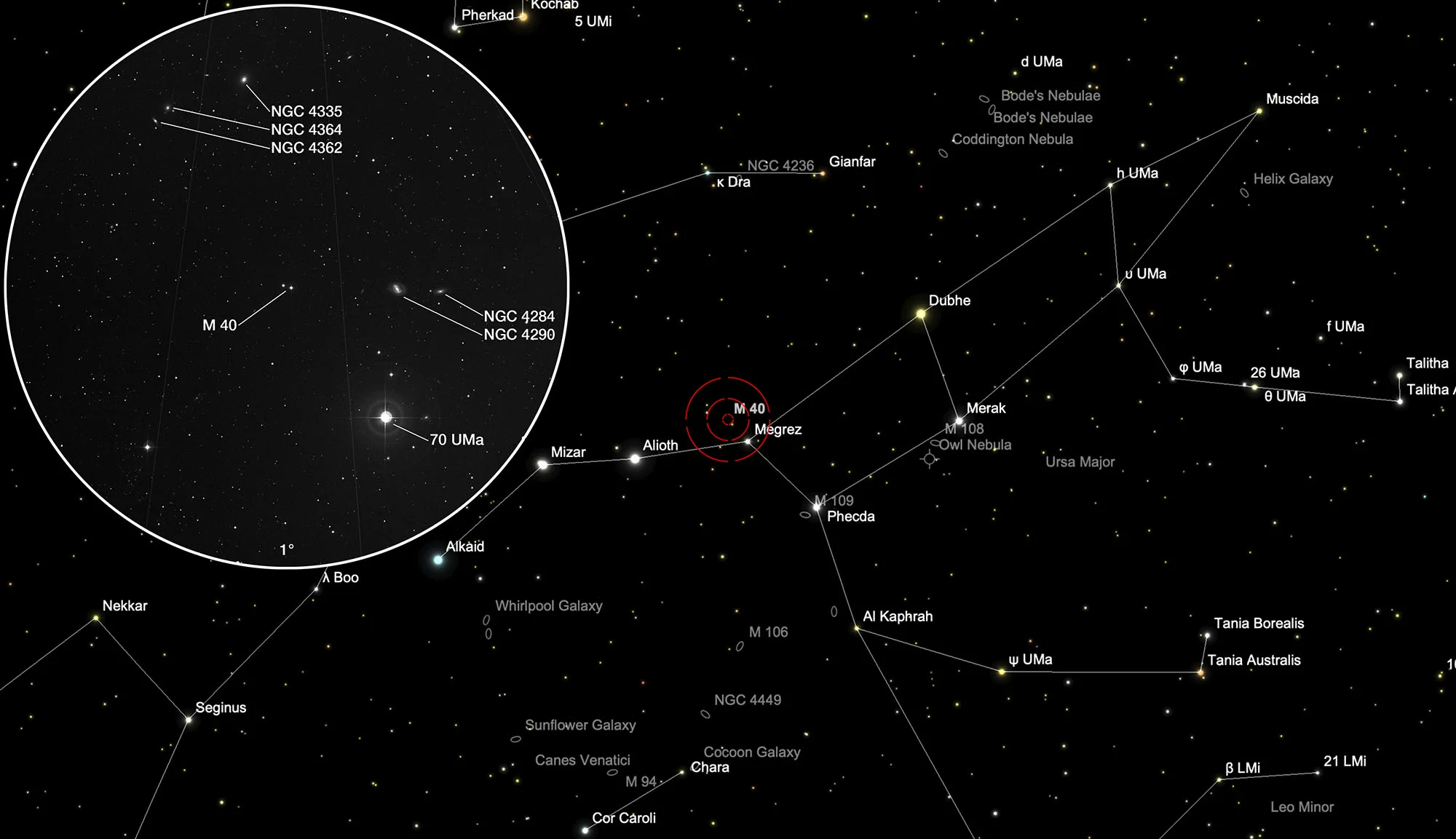Winnecke 4 (Messier 40)

History
Messier 40 is one of the few errors in the Messier catalog and is only listed here to complete the collection. On 24 October 1764, Charles Messier was looking for a «nebula over the ridge [of Ursa Major]» described by Hevelius, which he had mentioned in his 1660 work «Prodomus Astronimae». He wrote: «Two stars, very close together and very small, placed at the origin of the tail of the Big Dipper. It is difficult to tell them apart with an ordinary 6 foot telescope. The search is for the nebula that is located over the back of the Big Dipper, which was reported in the Book of the Star Figure of 1660.» [281] But there is no nebula here that Hevelius could have seen, but only two very close together 9th magnitude stars. They might not have been clearly seen with the telescope of the time under poor observation conditions and were mistaken for a nebula.
Physical Properties
M 40 is identical to the double star Winnecke 4, which was added in 1863 by the German astronomer Friedrich August Theodor Winnecke as the 4th object in his list. The two stars are about 50 arc seconds apart. Later measurements with the space probes Gaia and Hipparcos showed different parallaxes of the two stars HD 238107 and HD 238108, which makes it clear that they have nothing to do with each other and just happen to be close to each other from our perspective The star HD 238107 (west) is 317 pc (1034 light years) away and the star HD 238108 (east) is more than twice as close at 145 pc (437 light years). [4, 145]
Galaxies Nearby
The galaxies in the immediate vicinity with the size classes 12 to 15 are much too weak for Messier - let alone Hevelius - to see them.
| Name | RA | Dec | Type | bMag | vMag | B-V | SB | Dim | PA | z | D(z) | MD | Dreyer Description | Identification, Remarks |
|---|---|---|---|---|---|---|---|---|---|---|---|---|---|---|
| NGC 4284 | 12 20 12.8 | +58 05 36 | Gx (Sbc) | 14.3 | 13.5 | 0.8 | 14.5 | 2.5 × 1.2 | 102 | 0.014023 | 59.23 | 68.850 | cF, lE, p of 2 | WH III 798; GC 2860; UGC 7393; MCG 10-18-26; CGCG 293-11; KCPG 329A |
| NGC 4290 | 12 20 47.5 | +58 05 33 | Gx (SBab) | 12.8 | 12.0 | 0.8 | 13.2 | 2.2 × 1.6 | 90 | 0.010114 | 42.72 | 42.100 | pB, L, R, gmbM | WH II 805; h 1193; GC 2866; UGC 7402; MCG 10-18-29; CGCG 293-12; KCPG 329B; IRAS 12183+5822 |
| NGC 4335 | 12 23 01.9 | +58 26 40 | Gx (E2) | 13.4 | 12.4 | 1.0 | 13.6 | 1.9 × 1.5 | 145 | 0.015417 | 65.12 | pB, S, E, gbM | WH II 806; h 1217; GC 2897; UGC 7455; MCG 10-18-35; CGCG 293-15 | |
| NGC 4362 | 12 24 02.1 | +58 23 07 | dup | 14.2 | 13.2 | 1.0 | 12.8 | 1 × 0.8 | 170 | 0.015000 | 63.36 | cF, cS, R | WH III 800; GC 2918; NGC 4358; UGC 7479; MCG 10-18-38; CGCG 293-17 | |
| NGC 4364 | 12 24 11.3 | +58 21 39 | Gx (S?) | 14.6 | 13.7 | 0.9 | 13.4 | 1.1 × 0.4 | 39 | 0.015107 | 63.81 | vF, cS, R, r | WH III 801; h 1233; GC 2920; MCG 10-18-39; CGCG 293-18; CGCG 293-17 |
Finder Chart
M 40 is located in the constellation Ursa Maior above the upper left box star Megrez (δ Ursae Majoris), directly at 5.5 mag bright star 70 Ursae Majoris. If you don't just want to look at an optical double star, you can search for the five faint galaxies in the vicinity. The constellation is highest in the sky from December to August.
Visual Observation
400 mm aperture: The optical binary star Winnecke 4 is rather unimpressive. The galaxy NGC 4290 is distinctive and appears oval. The other galaxies in the same field of view only appeared as fuzzy patches, partly only via averted vision. — Taurus T400 f/4.5 Dobsonian, Bernd Nies, Glaubenberg Langis, 28 February 2022
